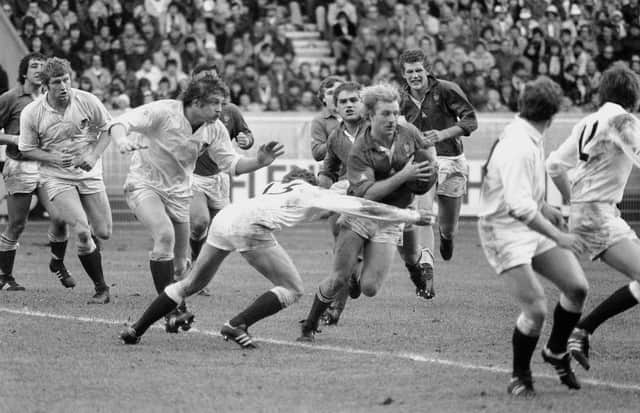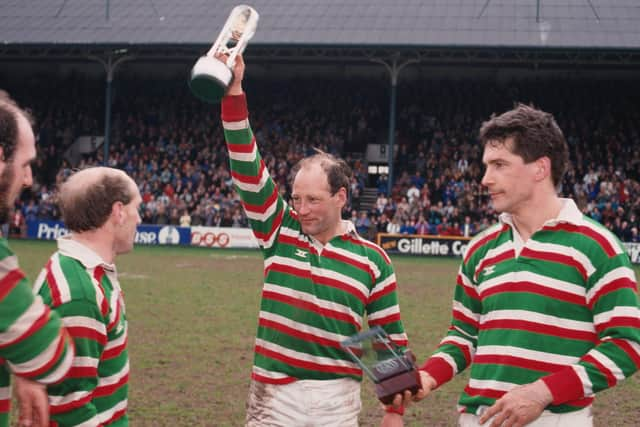How Notts cricketer became a British rugby union sensation


Dusty Hare made 17 first team appearances for the county but became better known as a British Lion and Grand Slam winning rugby union full back.
Hare attended the Magnus School in Newark but his academic achievements were always going to be outshadowed by his prowess on the sports field.
Advertisement
Hide AdAdvertisement
Hide Ad“I played both at school but was strongest at cricket,” he revealed. “I left in the lower sixth after being picked up by Notts Colts and went off to play for them in the Notts amateur league. I was also playing for my home club Collingham in the Notts Alliance.


“I was only 16 and got an early chance to play for Notts seconds at Boots ground (Lady Bay) against Leicestershire,” he said.
“I got 60 or 70, mainly playing off the backfoot, something I’d had to do a lot at Collingham. Reg Simpson was there watching and loved the way I’d played, so much so that he switched the order in the second innings for me to go out and open.”
“It was a time when the county were clearly looking for some new young blood and had decided to go with a youth policy. I was taken onto the books soon afterwards, along with Derek Randall and Bill Taylor,” recalled Hare. “Phil Wilkinson then joined, as well as two West Indians, Nirmal Nanan and Boya Sahadeo. Then they took on Paul Todd, someone I’d known since I was 14.”
Advertisement
Hide AdAdvertisement
Hide AdAfter a first-class outing at Oxford University, Hare was given a county championship debut away against Somerset at Glastonbury in 1973.
“The wicket was wet and hadn’t been covered,” he remarked. “When I went out to bat Garry Sobers was at the other end. He wasn’t having any problems at all but I couldn’t get it off the square.
“Tom Cartwright was bowling for them and he was doing all sorts on it. The wicket was right up his street. I couldn’t get him away and eventually he got me out lbw but Garry was disgusted with the decision and definitely felt that I wasn’t out. I just think the umpire had had enough of me!”
Hare’s volume of second team runs ensured a number of chances at the higher level but it didn’t quite materialise there for him.
Advertisement
Hide AdAdvertisement
Hide Ad“I became a useful second team player and ended up having four years on the staff. I think if I’d been any good they were looking at me as being a future captain because I could read a game and set a field but I just didn’t score enough runs to be seriously considered.
“I didn’t have a problem with the mental side of sport I just didn’t quite get on top of my game and too often I got out stupidly.”
The right-handed middle-order batsman and occasional medium-pacer played 17 times in total for Notts, 10 in first-class and seven in the one-day competition, where his versatility came in handy on one occasion.
“We were playing against Middlesex at Trent Bridge and Basher Hassan broke his thumb whilst batting, so I ended up taking the wicket-keeping gloves.”
Advertisement
Hide AdAdvertisement
Hide AdHare kept tidily enough and not only picked up a couple of catches, he also bagged a stumping.
“Mike Brearley was the batsman and Bob White was the bowler. I saw Bob a couple of years ago and we talked about it.
“He joked that Mike was the unluckiest bloke around. Bob drew him forward with a little awayer and I just lifted one bail off. It was a professional bit of work really but that was the problem, I was a ‘Jack of all trades’ but the master of none.”
Whilst he had reached his ceiling in one popular ball sport, he was still climbing the ladder to success in another.
Advertisement
Hide AdAdvertisement
Hide Ad“Rugby then started to take over for me, first with Nottingham and then I won my first England cap in 1974, whilst still on the full-time staff at Trent Bridge. Then I moved to Leicester two years later.”
It was pretty full on for Hare at that time as he would spend the winter working on the family farm at South Clifton.
“All cricketers had winter jobs then, I remember Bob White sold Birthday Cards and Christmas Cards.”
During that period it was fashionable for some of England’s finest rugby talent to combine their time with summers on the cricket field.
Advertisement
Hide AdAdvertisement
Hide AdOne of Hare’s rivals for the England full back position, Alastair Hignell, played for Gloucestershire and winger Peter Squires made 49 first-class appearances for Yorkshire.
Two England international fly halves made appearances against Notts; Alan Old, brother of England bowler Chris, played against them in the Benson and Hedges Cup for Minor Counties North in 1975, having made one appearance for Warwickshire and Rob Andrew, currently serving as CEO at Sussex, scored a first-class hundred at Trent Bridge for Cambridge University.
“It worked out well then, rugby was played from September until the end of April and cricket was usually from the start of May until around the end of August, so you could comfortably play both sports.”
Hare and Squires were on opposing sides in a championship match at Bradford in 1973, a fixture that he remembers well.
Advertisement
Hide AdAdvertisement
Hide Ad“Garry Sobers had been my boyhood hero and I’d always gone along to watch him whenever he played at Elm Avenue in Newark. He was worth the admission price on his own.
“That day he’d helped get Yorkshire to about 100 for nine but Geoff Boycott was still there, playing his three shots.
“Time and time again Garry kept beating the bat, he was bowling too well to get him out. Boycs and last man Mike Bore eventually put a further 100 on for the last wicket.”
Despite leaving the full-time staff at Notts, Hare would still make regular appearances for the second team for a further four or five years and made a return to the championship team in 1977, some three years after his last outing.
Advertisement
Hide AdAdvertisement
Hide Ad“I don’t recall how it came about but it was at Ilford against Essex and the two things I remember most from the week were going out for a hot curry and having a few beers with Graham Gooch, who I’d played a bit of England Under 19s cricket with.”
Hare’s last game of rugby was in 1989 but he remains the sport’s highest points scorer of all time, with his tally of 7,337 being the most in first-class rugby right across the globe.
“It will never be beaten,” he stated. “Nobody will play enough games to beat it. When I was involved I’d always play more than 40 games a season. No-one does more than 30 nowadays.”
Hare, now 67, spent time at both Leicester Tigers and their fierce rivals Northampton Saints, after ending his playing days, fulfilling the roles of academy manager, chief scout and head of player recruitment across the two clubs.
Advertisement
Hide AdAdvertisement
Hide AdNow, with a little more time on his hands, he can’t wait to start watching cricket again.
“I love going to Trent Bridge for the T20s,” he revealed. “I like to sit in the Hound Road stand and have a few beers and watch it all unfold, seeing how the batsmen adapt to the bowlers and how the bowlers adapt their game to the batsmen.
“It’s a far cry from the limited overs stuff we played, when teams would tick along at one run an over.
“Of course, it might be a while before we can do that but I hope we’ll be allowed to go and watch the youngsters playing at Lady Bay.
“I particularly enjoy seeing them come through the system and prosper, that’s been my forte in rugby since I stopped playing and it’s the same in cricket, I really enjoy looking at the young talent.”